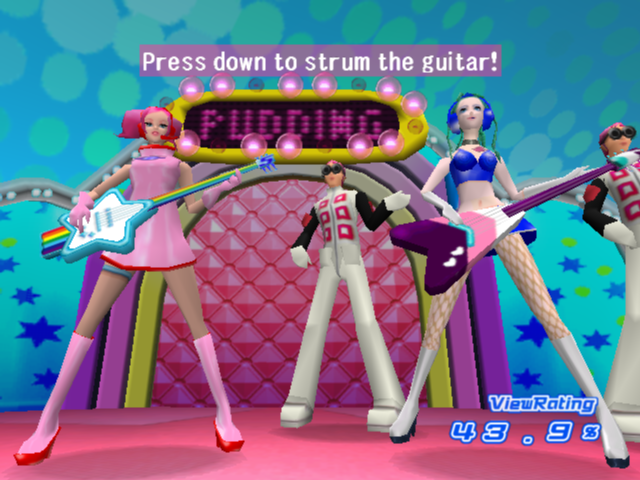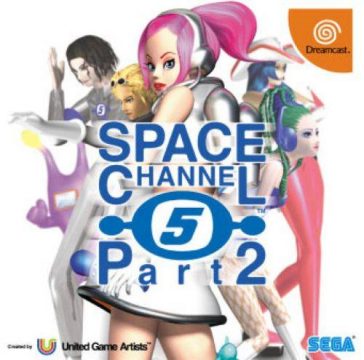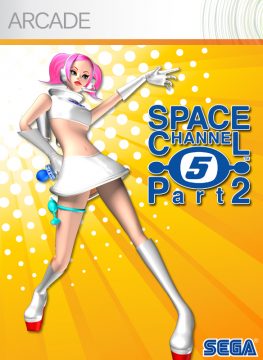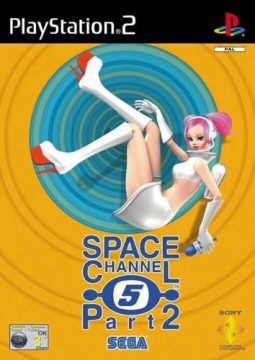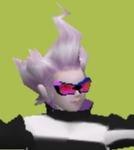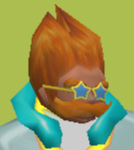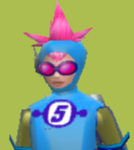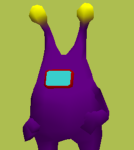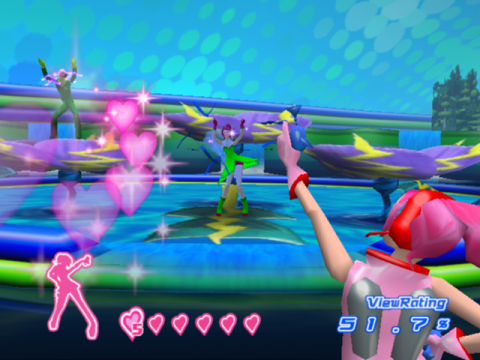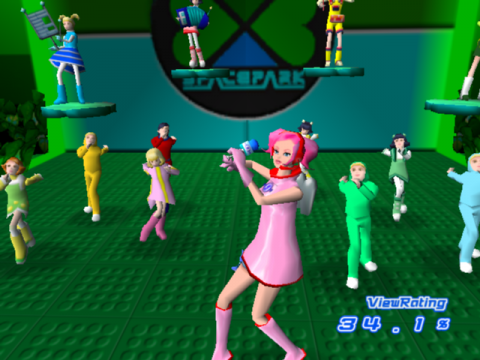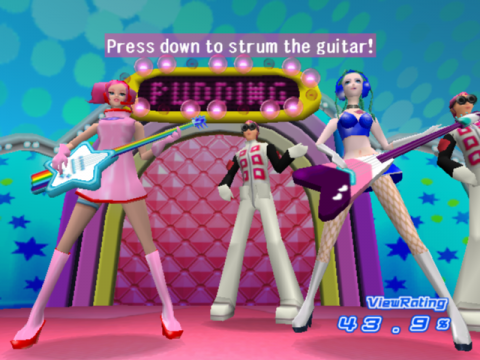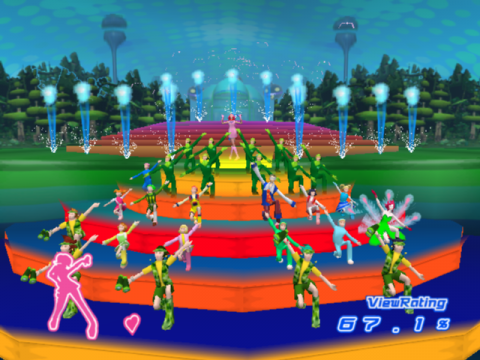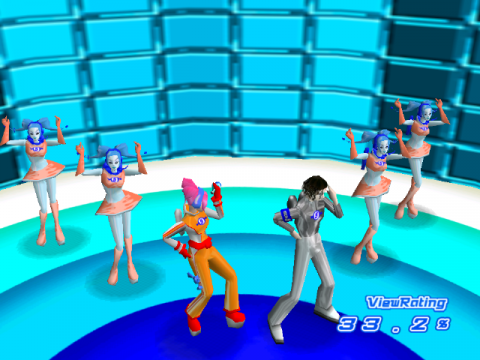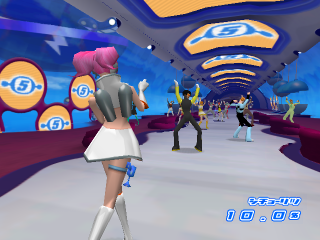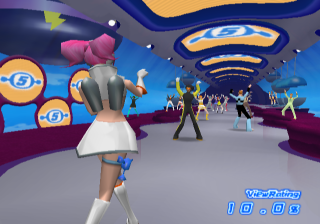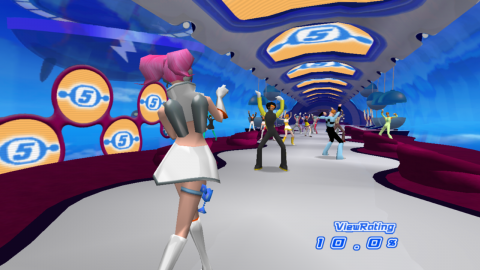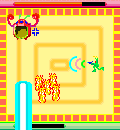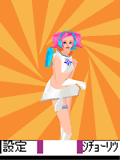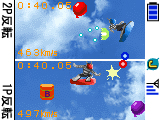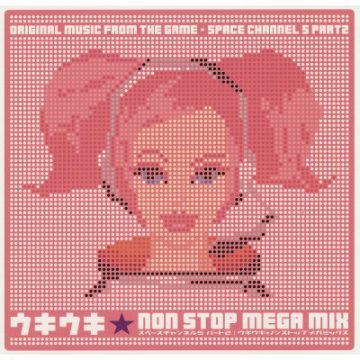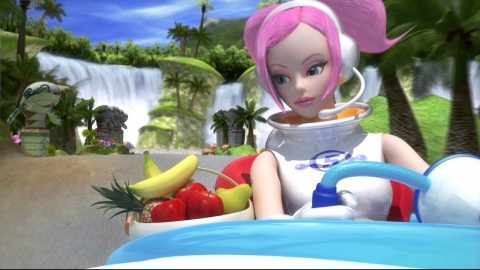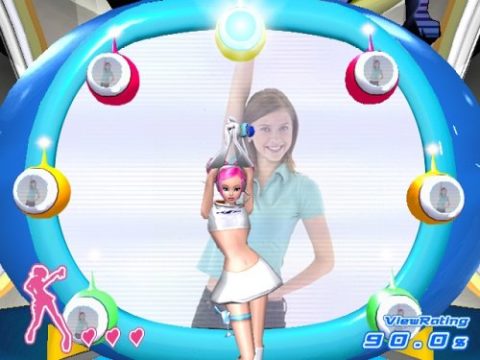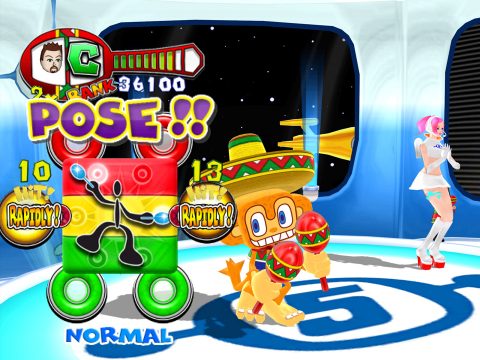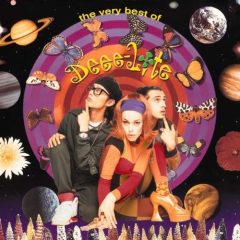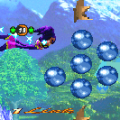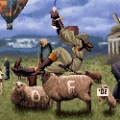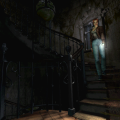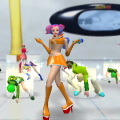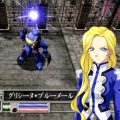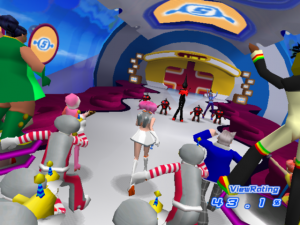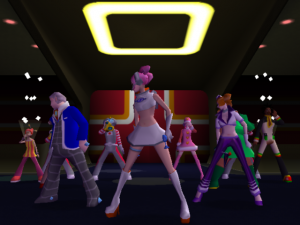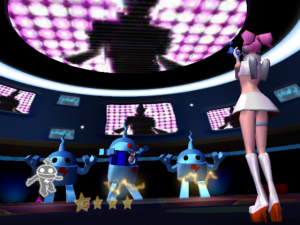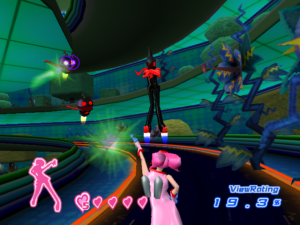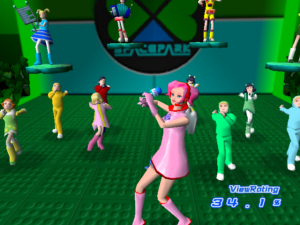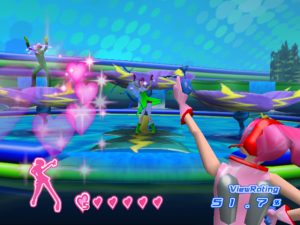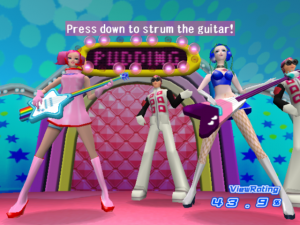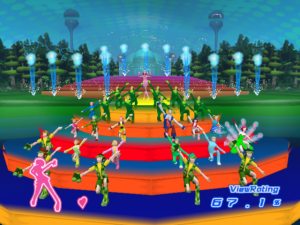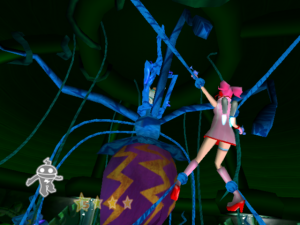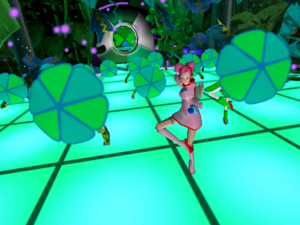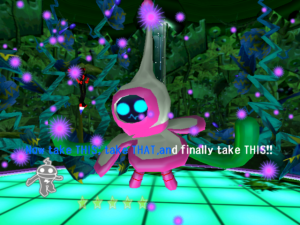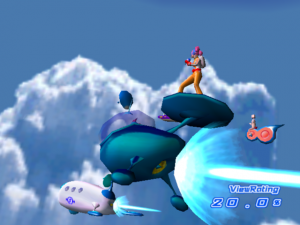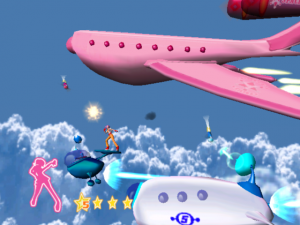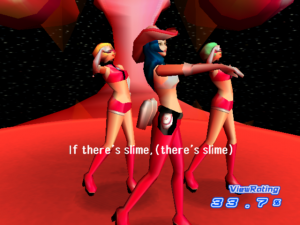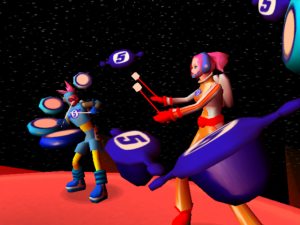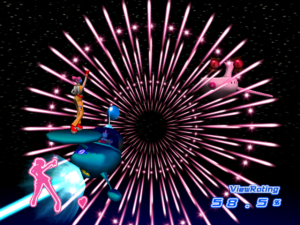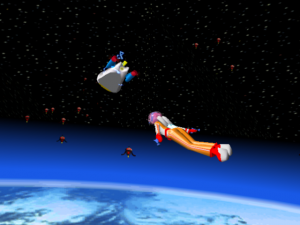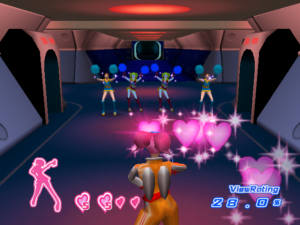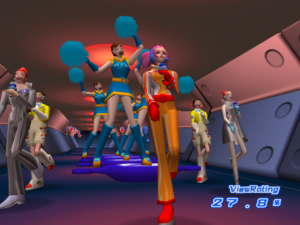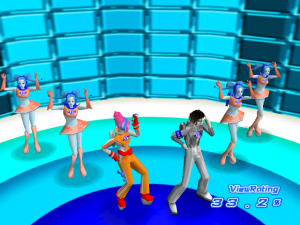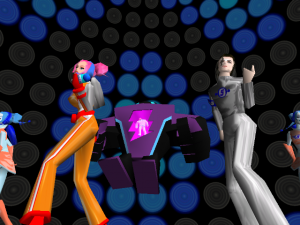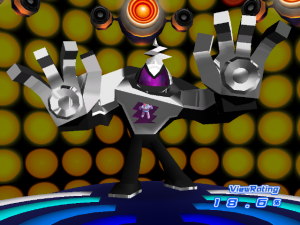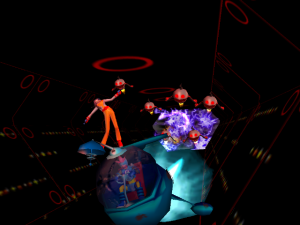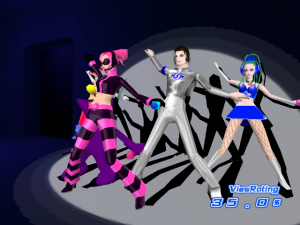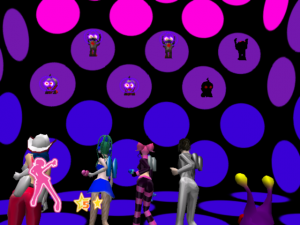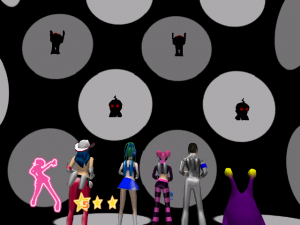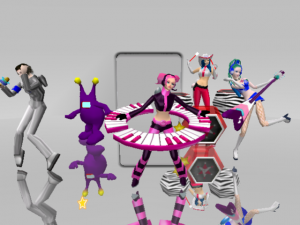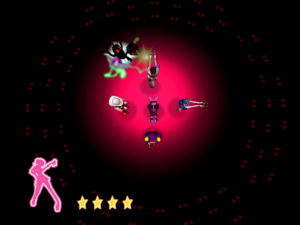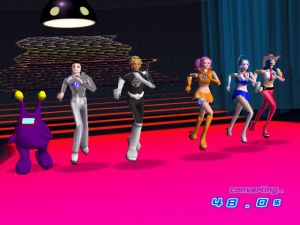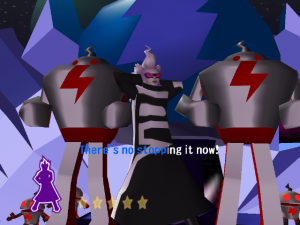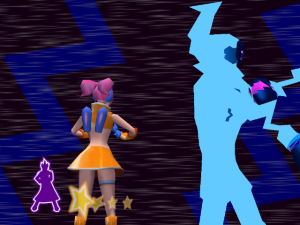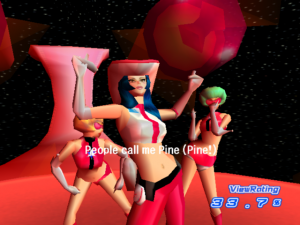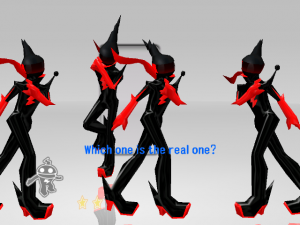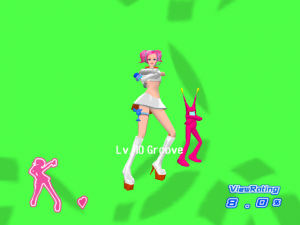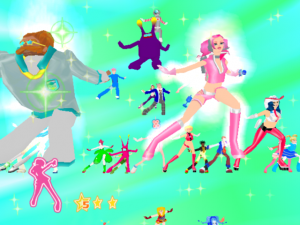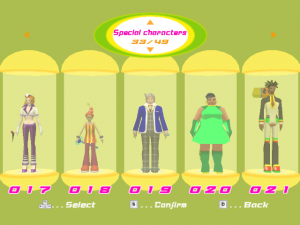- Space Channel 5
- Space Channel 5 Part 2
Ulala is back, and this time she has to save the galaxy from a new threat. These villains call themselves the “Rhythm Rogues,” and they command an army of robots. Once again, they’re handing out jitterbug fever to the general populace, and only Ulala can stop them. Only this time, the fight gets personal as the Rhythm Rogues proceed to take down all news stations in the galaxy, including Space Channel 5. Most of the ensemble cast of the first game returns, alongside a bunch of new characters:
New Characters
Shadow
Age 35. The major hindrance who tries to stop Ulala on several occasions throughout her quest. He is a big surbordinate of Purge in the Rhythm Rogues and an awesome singer, and so totally not a mind-controlled Jaguar in disguise it’s not even funny. Voiced by Tom Clarke Hill.
Purge
Age 18. The leader of the Rhythm Rogues seeks to overthrow President Peace and force the whole galaxy to dance for him by stealing the broadcasting equipment from all the stations in space, including Space Channel 5’s satellite. He amazes himself. Voiced by Eric Myers II.
President Peace
The main man in the galaxy. Purge seeks to overthrow him since, being the President and all, hes stands in the way of galactic domination. Quite the nice guy, he always wants to make people happy. His singing voice has enough energy to melt rock and make hearts cry. Voiced by Bob Sherman.
Noize
Ulala’s assistant. He drives that blue thing she rides around and supports her on the drums in one report. Also, he acts as the main advisor for Ulala after Fuse, erm… goes away. Voiced by Alan Marriott.
Hoorg
While he was featured in the first game as the Morolian Boss (a title he still holds), he now becomes the main Morolian reporter used in all the inbetween-level cutscenes. He’s nice enough to help Ulala in the end, just like every other freaking person in the game.
Part 2 features the same great music and action of the first title, while adding more features and fixing previous problems. First off, whenever the player would hit a button in the first game, Ulala had to go through her whole animation for a direction or for the CHU command. Although a minor problem, it made the game feel a bit laggy with more complex sequences, even though her animation had nothing to do with how fast you could press buttons. Still, this was fixed in Part 2 by having Ulala move instantly in the pressed direction. The result is a much smoother experience. Also, a new move called “HEY!” was added. It’s now the same button used to rescue hostages in the first game, making it easier to understand who to shoot and who to save, while adding more variety to the dance combos. There are also “charged” commands that require to hold a button pressed for a certain amount of time.
Progression to the next level is no longer determined by a minimum rating. Instead on several occasions the quota is converted to stars, which replace Ulala’s usual heart meter, and running out of them means losing the stage. If the amount of stars given can be retained, then the ratings will soar when they are converted back after the battle. On the flipside, every lost star results in the loss of a good chunk of ratings. The ratings meter now extends to one decimal place, giving a better sense of standing as it constantly fluctuates, unlike the first game where it would remain static for a while and change only after a few sequences.
Every report starts off at a set rating that can be boosted to a max of 100% provided the player performs it with zero mistakes and finds all the hidden times to press CHU given in several NPC descriptions (save more hostages, get more secrets). Also, instead of the linear path needed to take in the first game, all stages are now selectable directly and display the highest rating attained.
It might seem hard to believe, but Space Channel 5 Part 2 is much more insane, colorful and chaotic than its predecessor. Ulala’s investigation lead her to a huge interstellar garden, a fight with law-inforcement first in the sky and then in outer space, and finally to the Rhythm Rogues’ dotted pop-art temple. The hostages Ulala gets to save are now grouped into sets, and aside from the instrument-wielding ones that put new layers on the music track, saving the whole group results in a garish concert while moving to the next area.
In some stages, incredibly cool instrument duels between Ulala and her various foes ensue. First she has to beat Pudding with a Guitar, then Noize joins her for a drumming match against Pine and the Space Police. Eventually the whole main cast gets together for a furious battle of the bands against Shadow nad his Rhythm Rogues. The instrument fights are actually easier than the rest of the game, since there is no need to worry about the cardinal directions, but that doesn’t make them any less awesome. There are now also some singing parts during dance-offs, but they bring no implications for the gameplay other than making it more difficult to time button inputs.
All graphics are now rendered in real time, so the characters stand out less from the scenery. The backgrounds are brighter and more detailed, while the character models look substantially better and more varied. The dance numbers are also more impressive than ever with absolutely grand choreography at several points. Especially boss fights include some gorgeous dance numbers with the whole group of saved hostages. Some of the music tunes are remixes from the original, while the new songs feature the same great up-beat style of the first game, ranging from the familiar swing to techno in the more intense scenes.
UGA also finally took some measures to account for the game’s replay value. The game is notably longer with six reports, doubled when adding in extra mode, which has been improved upon as well with more significant alterations to the standard run. Ulala did get a new costume for each stage in the first game, but they were all based on roughly the same orange design with different cuts. Now she has access to no less than 40 distinct “outfits” (many of which replace her model wholesale with different characters from the game) and 12 accessories that can be chosen as substitutes for her microphone. Aside from the costumes that come with each stage, more are unlocked by completing various achievements, which are hinted at on the Dressing Room screen.
Also new is the Ulala Dance mode, a 100 dance trial in front of a psychedelic background, with no tolerance for messing up. This is only made more difficult when ‘CHU’ and ‘HEY’ get changed to ‘WOOF’ and ‘MEOW’ or ‘HONDA’, and ‘TOYOTA.’ Space Channel 5 Part 2 also introduces two player variants for both the normal game mode and Ulala Dance. They’re not what one would have hoped for, though: The first player merely controls the directional buttons, while the second player is in charge of the CHU and HEY commands. Overall, it’s a stunning sequel that completely blows the first game out of the water, even though it still won’t attract anyone who didn’t like the original to begin with.
Space Channel 5 Part 2 was initially released on the Dreamcast and PlayStation 2 on Valentine’s Day 2002 in Japan only. While the latter version was also available in Europe, it was in limited quantities as a “promo edition” from Sony and is thus very difficult to find without a large price tag. Because it was localized in Europe first, all the voice actors besides Apollo Smile are British, speaking in American accents for continuity’s sake. For it’s belated North American release in November 2003, the original and Part 2 were sold in one compilation by Agetec (though still on 2 separate discs). Sadly, it still sold poorly and can often be found for bargin bin prices – notably on eBay. By all means, it’s easily worth what little money it costs for such an awesome and unique game.
In 2011, Space Channel 5 Part 2 appeared on Xbox 360 and Windows PCs as part of the Dreamcast Collection, the following standalone download also made it to the PlayStation 3. Besides a handful of uninspired Achievements or Trophies, widescreen HD support is really all the new versions add, though, and Space Channel 5 Part 2 is not exactly the game to gain the most from it. In fact, many scenes and camera angles make it obvious that they were set up for the confines of a 4:3 screen, with a crowded center and much empty space towards the borders. The stylized graphics and predominantly single-colored textures didn’t really scream for higher resolutions, either. Still, it’s great to have the game available on more recent platforms, and the arcade-like structure was predestined to make a great low-priced download title, anyway. Care has to be taken with the version available on Steam, though: It’s embedded in the Steam framework pretty badly, making it impossible to save the game or even the settings without a manual modification to the configuration files. Sega doesn’t seem to care enough to fix this.
Screenshot Comparisons
Mobile Games
Apparently the Game Boy Advance screen was as small as the Space Channel 5 formula would go, but that didn’t stop SEGA from exploiting the franchise for mobile devices by other means. Ulala no Channel J was a kind of hub service that enabled customers to download many Space Channel 5-themed mini games to Japanese Vodaphone models. It was only ever available in Japan, though, and discontinued in September 2005.
The sharp-manufactured model J-SH07 also came with Space Channel 5 java content, containing ringtones, Ulala speech samples an dancing 3D characters in the background. Both titles were launched in July 2001.
Soundtracks
There are six soundtrack releases for the series in total, none of which have been released Stateside. The first game’s OST contains all the tracks used in the game (22 total). Naturally that includes the original version and a remix of Mexican Flyer, the series’ signature song. A series of short little drama “programs” are thrown in for good measure. These are performed by the Japanese voice actors, of course, and thus are of no use without an understanding of the language. There was also a remix maxi exclusively for Mexican Flyer, including five remixes on top of the original version. Yes, an entire six tracks. They’re certainly unique if nothing else, but otherwise not the greatest remixes. Let’s just say you’re not exactly missing out if you never get the chance to hear them. You could just settle for the other 20 billion remixes Mexican Flyer has endured.
Part 2 took the soundtrack mania much further. Since the game was longer, it also had more music; at least enough for two full albums. The first, CHU!!!, contains 27 tracks; it’s the music for Report 1-3 together with several extras, including one of three fully vocalized songs (the others being Pine’s and Purge’s Themes, but they’re not as important). President Peace’s signature song, “This Is My Happiness,” is sung in Engrish by a Japanese voice actor. The second album, HEY!!!, has yet another 27 tracks, now from Report 4-6, several more extras and “This Is My Happiness” sung by an actual native English speaker (which is the version used in Space Channel 5 Special Edition).
Then two remix albums followed. The first, Can’t Stop Remix, has 23 tracks, about half of which are more of those fun little drama programs, but the remix part of the album is still very well done and has a nice variety of songs. All three vocalized songs (Pine’s Theme, Purge’s Theme, and This Is My Happiness) are featured as super remixes. The second remix album, Non-Stop Megamix, connects several songs and vocals (including the directional buttons thrown in on several occasions) together to make an unique sounding melange of songs. One remix actually includes a bit from Rez. There’s a couple of Mexican Flyer remixes put in, too, which completes an already superb album.
Cameos
Although there have been no new Space Channel 5 games ever since UGA was merged with Sonic Team in 2003, Ulala has appeared in most of SEGA’s IP clusterfuck party games in some form or another. She is a playable character in Sonic Riders, Sonic & SEGA All-Stars Racing and SEGA Superstars Tennis (the latter also features Pudding and a Space Channel 5 themed tennis court), while Ulala cosplay accessories can be unlocked in the Gamecube volleyball game Beach Spikers and the mini-game compilation Feel the Magic on the DS. Virtual idol Hatsune Miku in the PSP “game” Project Diva can also be dressed up as Ulala. In Phantasy Star Universe, a girl that looks similar to her is included and branded as a reporter for the game’s Channel 5 news show. Finally, in a discontinued online golf game called SEGA Splash! Golf, Ulala was among the SEGA-themed caddies.
But other elements of the franchise have popped up here and there, too. In Rez, also developed by UGA, there’s an unlockable Morolian form for the morphing player character, and Space Channel 5 itself appeared as a mini game in the Eye Toy game SEGA Superstars. A piece of music from the game was included in the Wii remake of Samba de Amigo, complete with a Spache Channel 5 themed stage and an appearance by Ulala.
Sometime in 2003, the star of Space Channel 5 was involved in a silly legal clash, which ultimately amounted to nothing more than a funny anecdote: Kier Kirby, known as Lady Miss Kier from the band Deee-lite and a former pop idol in the United Kingdom, claimed that SEGA had offered her $16,000 to use her image for Ulala’s character design. When she refused and SEGA went ahead and used that design for Ulala anyway, so her story goes, Kirby decided to sue. She claimed over $750,000 in damages. In the end, she lost the case three years later and had to pay for SEGA’s attorney fees instead – which amounted to more than $600,000.
